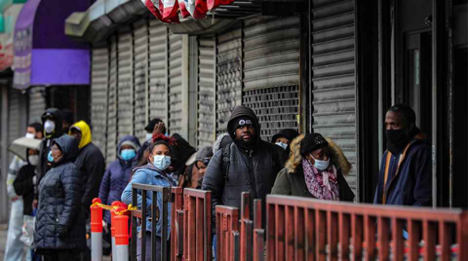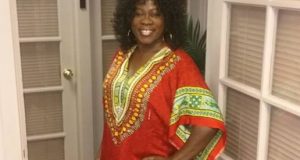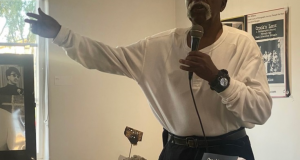White people, historically speaking, have been very comfortable building their economies on top of Black, Brown, and Indigenous bodies. This nation was born of genocide and slavery. It was raised on exploitation and exclusion. And in the face of death, Whiteness will feed Black, Brown, and Indigenous bodies to the beast long before it protects us as Brothers and Sisters from a common enemy.
And that is what’s happening now. White people have figured out how to protect themselves from the Coronavirus — for the most part.
There’s a saying: “You don’t have to be faster than the bear. You just have to be faster than the slowest person running from the bear.” White people think they have this race figured out.
White communities make enough money or have enough money to stay home if they need to. They can pay for their groceries. They can pay for their utilities, Internet, and phone service. They have access to information, entertainment, and each other.
Social distancing isn’t really a problem for them. They are more likely to own property and live in less crowded environments and households. They can have their groceries delivered to them — by people who aren’t White. They can work from home. They can drive (or take an Uber) instead of relying on public transportation. If they visit family members, they aren’t going into over-stuffed and under-maintained buildings. They aren’t going to jails, prisons, and homeless shelters at the same rates, either. That’s for other families.
White neighborhoods aren’t riddled with pollution and neglect. They didn’t catch asthma from the gas refinery next door. They haven’t suffered from the cancers triggered by the chemical plants in their back yards. They don’t have the hypertension and diabetes that comes with an abundance of racism and a lack of grocery stores and hospitals. White communities aren’t immune from these pre-existing conditions, but their communities aren’t characterized by them either.
They can also protect themselves more effectively from the virus if they do have contact with the public. They can and do hoard sanitizers, cleaning supplies, and masks. They have water. They have gloves and sewing machines and an endless string of Pinterest links for how-to-make your own PPE.
White folks, for the most part, don’t have to rely on public facilities at the same rates that Black and Brown and Indigenous communities do. They don’t have to make as many stops to make their ends meet. And most of the time, they can pay a person that isn’t White to take the risk for them.
According to a study reported in the New York Times
… 75 percent of front-line workers in the city — grocery clerks, bus and train operators, janitors and child care staff — are minorities. More than 60 percent of people who work as cleaners are Latino, and more than 40 percent of transit employees are Black.
And so Black, Brown, and Indigenous people are being fed to the bear.
White folks have it figured out. Or at least they think they have figured it out well enough to play the odds on sending America back to work. They think they can outrun the bear. They aren’t immune from the coronavirus, but White folks can reasonably buffer themselves from the virus by placing Black, Brown, and Indigenous bodies between themselves and COVID-19.
According to the New York Times …
The preliminary death rate for Hispanic people in [New York City] is about 22 people per 100,000; the rate for Black people is 20 per 100,000; the rate for White people is 10 per 100,000; and the rate for Asian people is 8 per 100,000 …. In New York City, Latinos represent 34 percent of the people who have died of the coronavirus but make up 29 percent of the city’s population, according to preliminary data from the city’s Health Department. Black people represent 28 percent of deaths, but make up 22 percent of the population.
According to EcoWatch …
In Chicago, where African Americans make up 32 percent of the population, they have accounted for 72 percent of virus-related deaths and more than half of all positive test results. Similarly, in Milwaukee, Blacks make up 28 percent of the population but have been 73 percent of all COVID-19 related deaths.
And this is just a sample of the findings from the very limited statistics that are being collected from communities of color. There are gaps in what we know – and Black and Brown bodies are falling through them.
The statistics we are seeing are coming from people that have been tested. They do not count people who have been denied testing, those who are turned away from hospitals and testing centers, those who don’t have access to testing, those who don’t seek testing, or those who die at home.
In other words, we aren’t seeing what is happening to Black, Brown and Indigenous people. These communities are often located in health care deserts and don’t have access to care. If they have care, it is often substandard. These communities often lack health insurance. And those that have had experience with the health care system have been tormented and traumatized by the racism within it. They often won’t seek care as a result.
Communities of Color Likely Have Their Own Coronavirus Curve To Deal With
The coronavirus infection curve may or may not be flattening for Black, Brown and Indigenous communities. We just don’t have the data to know.
New York is pointing to a dramatic increase in deaths from the same time last year. It is very likely that many of these deaths are coronavirus victims that never went to the hospital or that were turned away once they got there. We can reasonably assume that nationwide, the Black, Brown and Indigenous communities hit hardest are still being hit hard — or they are about to be. But we just don’t know where the curve is or how to respond to it without aggressive data collection. And that is literally killing us.
White nationalists and the people that support them are fighting to put Black, Brown and Indigenous bodies in the path of the virus. In the name of their economic success, they are pushing forward a plan to re-open the economy without knowing the impact this will have on the communities of color that are already being hit hardest.
Or maybe they do know — and they are OK with it. In either case, communities of color cannot allow this to happen.
We need to demand that no re-opening plan be accepted without a complete understanding of the impact of the coronavirus on communities of color at the local, state, and national levels. That means testing, data … and a lot of both. And more importantly, no opening can occur without the permission of these Black, Brown and Indigenous communities. That means an organized and loudly articulated plan for re-opening designed by and for leaders of color.
Communities of color have an unprecedented advantage right now. Local, state, and federal government can try to force open places of businesses, but these businesses cannot function without the labor of bodies of color. And that leverage carries power.
If this power is organized and leveraged, it can be used to ensure that there is no re-opening of America until there are plans put in place to address every single issue that makes communities of color more vulnerable to exposure and mortality from COVID-19 than other communities. We have a window of opportunity to end the overcrowding, the dilapidation, the pollution, and the neglect.
Hopefully this kind of dark opportunity never happens again, but at this moment target non-White communities are in a position to take control of the economy and how it moves forward. We need to grab it.
According to a recent report published by The Nation …
Amazon warehouse workers walked off the job in Detroit, Chicago, and New York City; in the latter, they’ve now staged two strikes in as many weeks over safety and pay concerns. Workers at fast-food restaurants such as McDonald’s, Burger King, KFC, Checkers, Domino’s, and Waffle House have gone on strike in California, Florida, Missouri, North Carolina, Tennessee. They’ve been joined by workers at companies where workers have never gone on strike before, such as Family Dollar, Food Lion, and Shell gas stations. Instacart shoppers held a national strike on March 30, refusing to accept orders. Workers for Shipt, Target’s same-day delivery service, organized a walkout on April 7. The unrest has even spread to bus drivers, poultry workers, and painters and construction workers.
Rent strikes have also been organized in efforts to force relief for households that just can’t pay the rent. Whether it is large scale rent strikes, work strike, or a combination of these and many other creative acts of resistance, we need to put our bodies in the way of the federal plan to re-open the economy before they are put in body bags because of the coronavirus. And we need to have some very specific goals.
We need an accurate account of the coronavirus’s impact on Black, Brown, Indigenous and Intersected communities. That can’t happen without a completely new paradigm for testing and data collection. Once we know the curves of color, we can articulate a phased plan for re-starting the economy. This plan will address every single issue that makes us vulnerable to exposure, contraction, and death. And we need leadership to step up and organize the coordinated nationwide effort needed to make this a reality.
Never have the stakes been higher. And never have the potential rewards been more expansive. Communities of color need to decide when America re-opens. If we don’t, White communities will decide when we die.
If we don’t organize to stop and redirect the re-opening of the American economy, we will be little more than bear food.
 Westside Story Newspaper – Online The News of The Empire – Sharing the Quest for Excellence
Westside Story Newspaper – Online The News of The Empire – Sharing the Quest for Excellence




